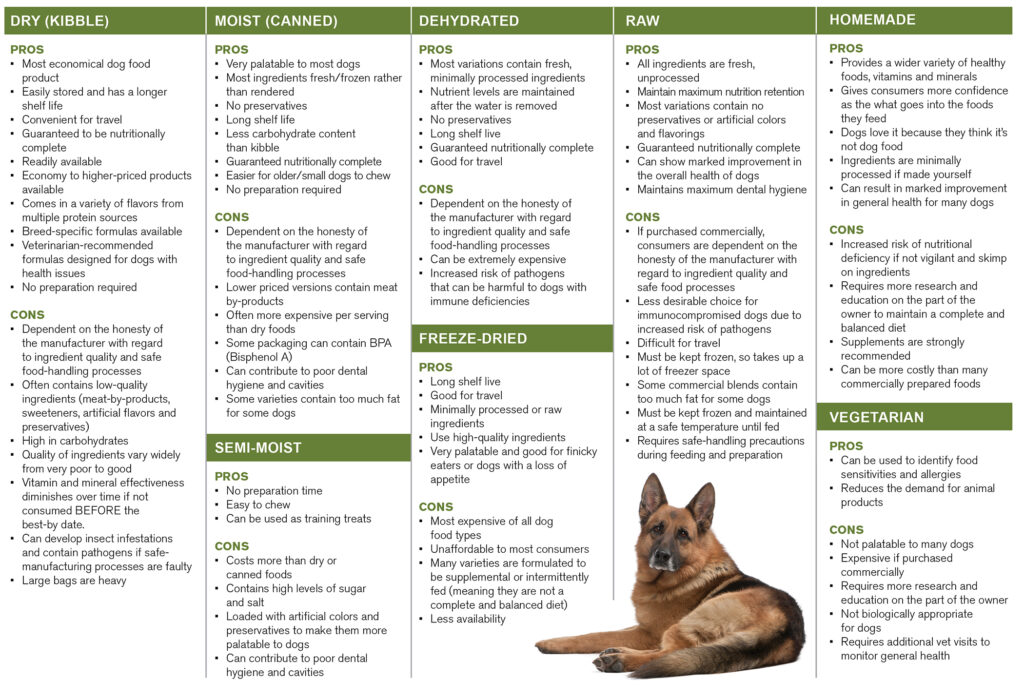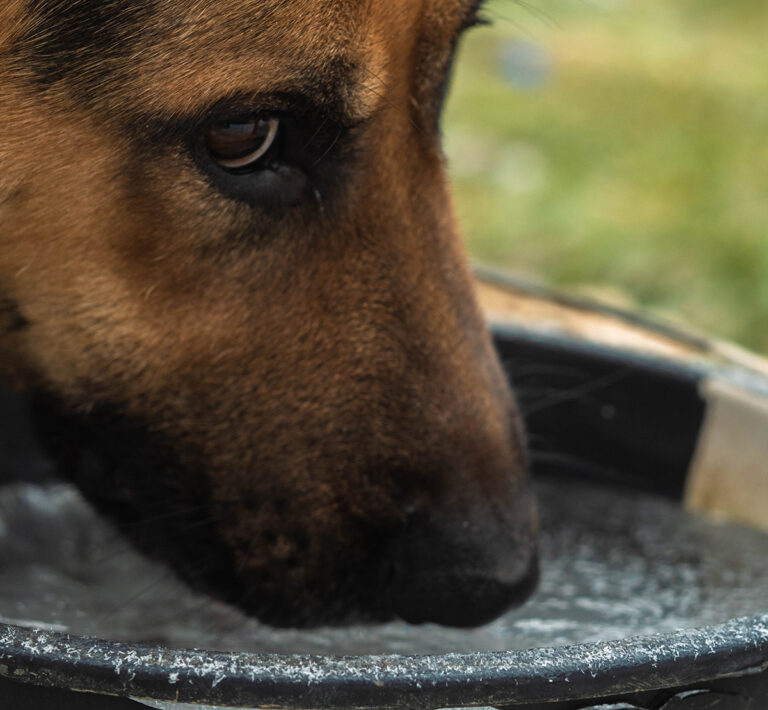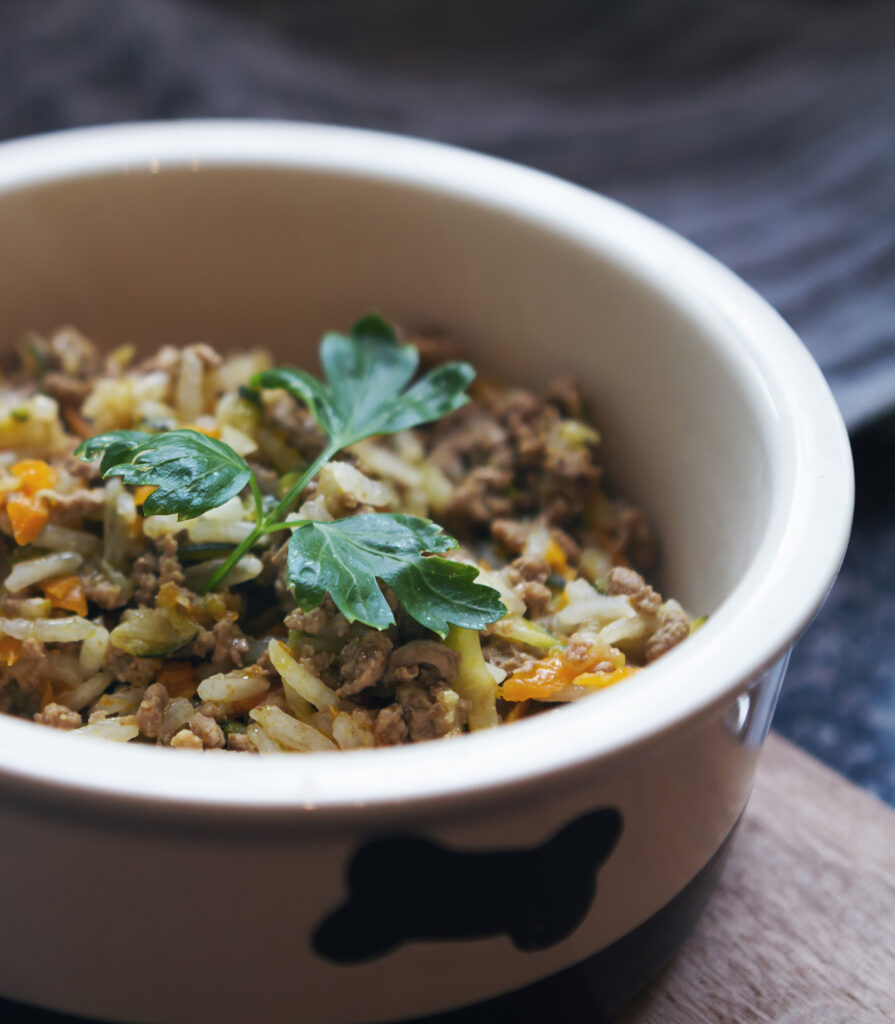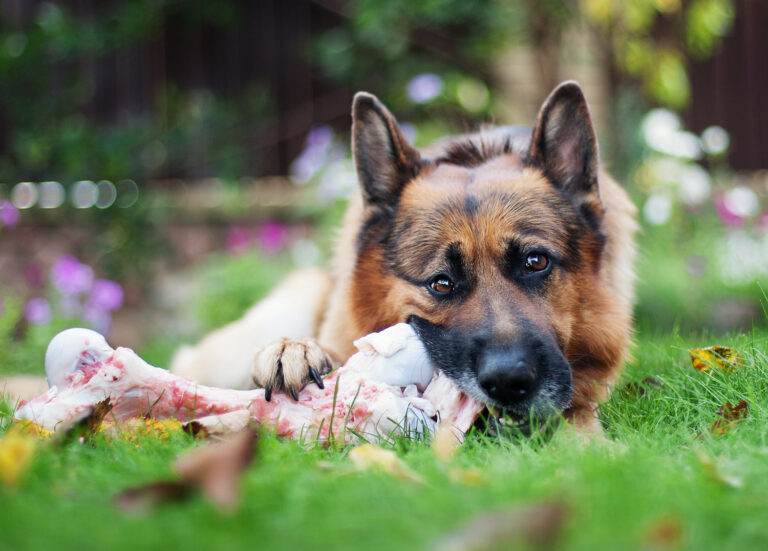
The GSDLiving pack (from left): Yevi, Hēlo, Reebok and Rin
Dog food selection can be daunting. There are as many options as there are breeds of dogs. Below are some basic guidelines and suggestions for selecting the best foods for your German Shepherd. For more in-depth information, check out our many diet-related articles in Reebok’s blog. Learn more about kibble-based, raw, homemade and vegetarian diets. Know the difference between grain and grain-free diets, the importance of high-quality ingredients and even try a few recipes. Feeding your dog a balanced diet is not as difficult as you might think. With patience and a basic understanding of canine nutrition, you can feel confident about the choices you make. So let’s get started.
Dog Food Selection
No singular diet works for every German Shepherd—let alone for every dog. Our goal is to help guide you through the food selection process. There are two guarantees with regard to canine nutrition. First, there is no perfect diet and second, everyone you talk to will tell you they know what is best for your dog. Dogs are as diverse as people and each has unique needs. What works for some, might not work for others. So pace yourself, do your research and make adjustments when needed.
At GSDLiving, we are proponents of feeding raw foods—or at least including raw foods—as part of your dog’s diet. If you are not comfortable with handling and feeding raw meat, there are many commercially prepared fresh foods and homemade diets that work very well for German Shepherds. Whether your preference is raw, kibble, homemade or a combination, rest assured you can find success. The only diet we do not recommend for healthy dogs is vegetarian diets because we do not believe they are biologically appropriate. This is not to say that dogs with allergies to animal proteins cannot do well on them. If you are interested in evaluating the pros and cons to feeding vegetarian, there are articles in Reebok’s blog discussing these diets and recommendations on how to feed them safely and confidently.
Lastly, understand that selecting a diet that is not right for your dog is not only okay—but common. Dogs are incredibly resilient and with knowledge and experience, you can discover the best diet for your dog.
Our goal at GSDLiving is to provide German Shepherd enthusiasts with the knowledge they need to select the highest quality foods possible—in a way best suited to their lifestyle and budget.
Simplifing the Process
There is more to selecting a good food than just choosing a name brand. When it comes to feeding your German Shepherd, there are things you can do to simplify your food selection process. Ask important questions and set priorities that can give you confidence and peace of mind that you are making the right choices for you AND your dog.
Make a List and Prioritize
The first step to evaluating dog food for your German Shepherd is to make a list of the things that are most important to you. Lifestyle, economic status and comfort level are important. Below are things to consider when beginning your food selection process:
• Kibble or canned (dry vs. moist)
• Dehydrated/freeze-dried or homemade, raw
• Homemade, cooked
• Grain or grain-free
• All natural, holistic
• Veterinarian recommended/formulated
• Palatability (for picky eaters)
• Special needs (allergies, digestive and/or health issues)
• Level of activity (working/competition dog, companion)
• Preparation time
• Cost
Wow, a lot to consider, right? But working through this list can lead you in the right direction by narrowing down your options.
Cost is a consideration for many as pet foods have become increasingly expensive. Homemade and raw diets can also be time consuming depending on whether you make it yourself or purchase it commerically. There are many premade raw and fresh commercial foods available if you don’t have a lot of time and cost is not an issue. If you have more than one German Shepherd and you want to feed raw, look for a local dog food co-op in your area. Many large-scale raw pet food manufacturers also offer shipping. If you have the time to prepare the food yourself, there are often commerical meat distributors that sell products off the dock that can be purchased at deep discounts. I recently looked into feeding my crew of four one of the premier homemade brands available online and their recommended plan would have cost me $1,200 a month. WOW! This option is obviously not for me, it might be great for a single-dog household or households with small dogs.
Premium diets such as all natural, grain-free and holistic formulas also fall into the higher price ranges. There are a number of economy diets available, but they are less costly due to lower quality ingredients. If you are on a budget, try to find a median-priced food and supplement with other nutritious ingredients or treats when possible. One example would be to add green tripe to your dog’s food when available.

Do Your Research
There are many good resources on diets for German Shepherds. If your dog or puppy came from a breeder, they should be your first point of contact about diet. Ask what they feed their breeding dogs and what foods are being fed to their puppy. You will want to keep with the same diet initially, even if it is not what you want to feed moving forward. Second, talk to your veterinarian. I personally don’t always agree with recommendations from my veterinary practitioners, but if you are new to dog ownership or have a puppy or adult dog with dietary intolerances, their can provide a good place to start. Third, ask local dog professionals (trainers and handlers) and other dog owners you might know. Visit sites like DogFoodAdvisor.com to learn more about the ingredients found in many brand name pet foods. Knowledge is power when it comes to selecting foods that contain quality ingredients.
If you have a dog or puppy with dietary issues and you have been unable to find a food that works well for them, the next step would be to seek the advice of a veterinary nutritionist. Always keep in mind that canine nutritional needs are widely debatable and opinions can vary greatly. What you choose today might not be what you feed in the future as your German Shepherd’s needs can change with age.
The Great News
Dogs are one of the most versatile and adaptable animals on the planet when it comes to diet. Most dogs, like people, can survive and thrive on an endless variety of foods and diet plans—even those that some deem less than ideal. The key to feeding a healthy diet is variety and balance over time. If you feed your German Shepherd a combination of foods from a number of different sources, the diet is less likely to be unbalanced.
The most important take-away in beginning your dog food selection journey is to not get wrapped up in a fear of causing harm to your dog. Dogs are incredibly resilient and most can eat a huge variety of foods. Introduce different diets slowly and change, tweak and supplement as needed.
Most dogs, like people, can survive and thrive on an endless variety of foods and diet plans—even those that some deem less than ideal. The key to feeding a healthy diet is variety and balance over time.

Which Diet Is Best for German Shepherds?
German Shepherds are working dogs. Like athletes, they require high-quality foods to maintain optimum health, strength and endurance. Whether your German Shepherd exhibits strong working traits or not, its fundamental nutritional requirements remain the same. Diet can have a direct impact on your German Shepherd’s overall performance and mental and physical well-being—especially if you regularly exercise, train and/or compete with them.
German Shepherd Dogs are amazing animals, but the breed does not come without heartache. Like so many purebred dogs, poor breeding practices and an insatiable quest to produce the next world champion—while ignoring health and genetics—have led to a breed predisposed to a number of health issues. These can including hip and elbow dysplasia, heart disease, digestive disorders and severe allergies to name a few. Some of these issues can be prevented—or at least minimized or delayed—by feeding a nutrient-rich diet.
Often, it’s easy to tell a healthy German Shepherd from an unhealthy one. A healthy GSD is alert, has bright eyes, a shiny coat and boundless energy. Genetics and environment also play an important role in overall good health. But you can’t always judge a book by its cover. Just because a dog might look good doesn’t mean all its fundamental nutritional needs are being met. Some dogs can handle and even thrive for long periods of time with very poor nutrition if their genetic makeup is strong and environmental influences are few. I have known children who have been raised almost exclusively on chicken nuggets, pizza and mac-n-cheese—to adulthood. A vegetable has never passed their lips, and yet, they appear perfectly healthy. Perhaps they have great genes, or their bodies metabolize junk food better than most, or maybe health issues won’t manifest themselves until later in life. And some might even live to a ripe old age. The same goes for dogs.
The take away here is if you want your dog to receive all of it’s basic nutritional needs and you want to increase it’s odds of living a long, extended life, know and understand what is in the food you are feeding, what foods you want your dog eating and what foods yield the best results for YOUR dog.
Fundamental components of a German Shepherd diet include:
• Protein (high-quality animal sources)
• Essential vitamins and minerals
• Essential fatty acids (omega-3)
• Complex carbohydrates
• Fiber

There are as many combinations of the above mentioned nutrients as their are dog food formulas. The nutritent percentages can vary widely. This is why answering basic questions like: what breed is your dog, how active is it, how old is it and what health issues does it have, are so important. The answers can help guide you toward the best formulas for your dog.
NOTE: NOT ALL FOOD SOURCES ARE CREATED EQUAL. If you purchase an inexpensive food, the ingredients will be inexpensive, and in most cases—inferior. The lion’s share of your German Shepherd’s diet should consist of protein (with its associated vitamins and minerals), followed by fat, complex carbohydrates and fiber.
Know what proportions of these primary ingredients are in the foods you feed and read pet food labels. A German Shepherd’s diet should be mostly animal protein, followed by fats (<10 percent), complex carbohydrates (<10 percent) an fiber (<5 percent). If your GSD is high energy and/or training for competition and burning a lot of calories, then fat and/or complex carbohydrate content can be increased as needed. Conversely, if your dog is older, overweight and more sedentary, the percentages of fats and/or complex carbohydrates should be reduced.
Vitamin C is an essential component of a healthy diet for German Shepherds. Great sources of vitamin C are organ meats, such as liver and kidney, and some fruits and potatoes. Vitamin C promotes joint health (critical for this breed) and improves coat health. It can also boost immune response and even help to prevent some cancers.
Check out Reebok's blog article on omnivores vs. carnivores, the controversies and where dogs fall within the mix. Has domestication altered canine physiology and digestion?
Dog Food Types
Dog foods come in many forms and most can be fed to your German Shepherd either singularly or in combination. They include dry, moist, semi-moist, dehydrated, freeze-dried, raw and homemade. Let take a brief look as each.
Raw – A raw dog food diet is designed to mimic a dog’s natural, ancestral diet. The ingredients of raw diets include muscle meat, organ meat (liver, kidney, etc.), whole or powdered bones and meaty bones. Raw diets can also include raw eggs (with the shell), dog-friendly fruits and vegetables and dairy (cottage cheese and yogurt). Benefits can include much smaller, firmer stools, improved digestion, healthier skin and coat, reduced allergies and better weight management. Raw diets are an excellent alternative for dogs struggling to thrive on commercially prepared food products.
Dehydrated and Freeze-Dried – Dehydrated and freezed-dried dog foods consist of raw, healthy ingredients with the water removed so increase shelf life and use less space, i.e., a 3.5-pound box of this form of dog food in its dry state makes about 14 pounds of food once warm water is added. Most varieties include an identified meat protein, while others are meant to be used as a base and you add your prefered meat source. These mixes are great for dogs with food sensitivities and most of are also gluten-free. The down side to these products is they are very expensive and cost prohibitive to most large-breed dog fanciers.
Moist (canned) – Moist dog foods have a very high moisture content. Typical forms include a firm or chunky pȃté or loaf, chunks in jelly or chunks in gravy. Refrigerated and frozen moist dog foods are also available. Moist foods are traditionally more expensive than dry foods, though usually has a fairly long shelf life. Special attention should be paid the protein and water content of these foods. The higher the water content, the less nutrients in the food. This means your dog will need to consumer more of this food to meet his basic nutritional requirements. Look for a food that is 100% nutritionally complete, and be sure to read the label completely before making your purchase. Avoid products containing byproducts and unidentified meat products such as “meat-by-products.” Moist dog food is asier for senior dogs or dogs with poor dental health to eat as it requires little or no chewing.
Dry (Kibble) – Dry dog food, or kibble, is the most commonly fed form of dog food because it is the most economical and requires little or no preparation time. Dry foods are also easy to store and have a long shelf life. They do not need to be frozen or refrigerated. Because of the very low moisture content of these products, kibble-fed dogs should always have plenty of fresh water available—at all times—as they need to consume more water than dogs that are fed higher-moisture foods.
Semi-moist – Semi-moist dog foods are the least popular form of food sold in the U.S., but it is a popular form of dog treat. Most experts do not recommend semi-moist foods as they are the least nutritional of all the pet foods and usually contain many artificial flavors, coloring and preservatives to make the food more palatable to dogs. If you’re thinking about feeding your pup a semi-moist product, it’s best to use it as treats only and sparingly. Do not feed these products to any dog as a primary dietary source.
Vegetarian – Newly introduced into the market are vegetarian diets for dogs. Many dogs, however, are reluctant to eat these foods because they do not taste good. While some of these products are nutritionally complete, if your dog does not like the taste, feeding time can be challenging. There are a couple positive aspect to these diets. They are an option for dogs that have allergies to animal protein and they can be used to help identify your dog’s dietary sensitivities related to meat and dairy products. Since vegetarian diets do not contain these products, owners can start their dogs initially on these diets and slowly add back in animal protein and dairy products—one at a time. By doing so, they can determine which foods are causing issues for their dogs and eliminate these products from their meal plan.
If you have an otherwise healthy dog, and don’t have a strong veterinary medical reason for feeding a vegetarian diet, we recommend that they not be fed long term. The digestive systems of people and dogs are NOT THE SAME and neither are their dietary requirements or preferences.

Dog Food Type Pros and Cons

German Shepherd Feeding Tips
1. Keep fresh, clean water available at all times
While food is the central component of any diet, it is critical to ensure your German Shepherd drinks sufficient amounts of water—daily. Water is vital for maintaining biological systems and function and if you feed primarily kibble (very low moisture content), then water becomes more important. If your dog’s systems are not functioning properly, poor nutrition can result even with the best of diets.
2. Feed your German Shepherd at least twice daily
German Shepherds are a large, deep-chested breed and are therefore predisposed to developing life-threatening bloat or gastric torsion. To decrease these risks, feed your German Shepherd at least two smaller meals daily and at regularly scheduled times. Avoid late night feeding and make sure your dog gets plenty of exercise during the day. Never feed your German Shepherd when it’s in a state of excitement. Excitable states and eating can contribute to stomach problems, flatulence and other digestive issues. Additionally, wait at least 1-1/2 to 2 hours before and after exercise before offering food to your dog.


3. If store-bought foods don’t work, try a homemade diet
There are certain German Shepherds who have allergic reactions to a number of things which are often found in commercial dog food, such as wheat, beef, and lamb. Dog owners of such dogs admit that it’s certainly a challenge to find good-quality dog food that doesn’t have such ingredients. In such a case, you can certainly aim to provide homemade meals for your dog with the advice of dog food experts. While it is homemade, it is essential to make sure that it contains all of the nutrients that your dog needs. In fact, after the 2007 pet food recalls, many people began making their homemade diets for their dogs just so they can control exactly what their dogs are consuming. Here is a good resource for creating a homemade diet for your German Shepherd.
4. Do not “free feed” your German Shepherd (or any dog)
While it can be more convenient to fill up a bowl with food and leave it out all day, allowing a dog to munch at will is not a good idea. Dog food can attract pests, especially if it is left outside; and during house training, free feeding makes it impossible to establish a routine. Puppies need to relieve themselves after eating. If your puppy is allowed to feed at will, you won’t be able to tell when it should go outside. Lastly, your German Shepherd needs to know that his food did not just came out of nowhere. By having your dog recognize that you are the provider/giver of the food, he’ll learn to appreciate and respect you more.
5. Healthy human foods are great for German Shepherds
You can certainly feed your German Shepherd with healthy foods such as meat, bread, certain fruits and vegetables as treats. One reason to do this is that fresh foods contain natural enzymes that processed foods such as commercial dog foods don’t have. Be sure that human food does not account for more than 15% of your German Shepherd’s diet, given that more human food could upset your dog’s balance of nutrients.
6. German Shepherd lifestyles and nutritional needs vary
There is no fixed amount of food that every dog should be eating. While most dog food manufacturers have a chart showing the amount of food to feed your dog, it is to be noted that these are only recommendations. Each dog needs a different amount of food as this is based on your dog’s metabolism and activity rate, as well as lifestyle. Dog owners can often tell firsthand if their dog is not eating enough or eating too much. For instance, if your German Shepherd is thin and is always hungry, give your dog more food.


7. Avoid abrupt dietary changes
If you do decide to change your dog’s German Shepherd diet for any given reason, be sure not to do it all at once. You should mix the foods such that your dog as 25% new food and 75% old food for a week, Then, if your dog is doing well with this change, increase it to a 50-50 proportion for another week. Finally, change this proportion to 75% of new food and 25% of old food during week 3 before completely changing your dog’s diet in week 4. Doing so decreases the chances that your dog experiences an upset stomach.
8. Nutritional changes take time
If the food you’re feeding your German Shepherd does not fulfill its basic nutritional needs, and you want to switch to a different plan, keep in mind that changes should occur slowly. Experts recommend you stick to the same diet for a minimum of 6 weeks before evaluating the results and making any changes. Make small changes over a period of weeks.
9. Give your dog a bone?
What makes a bone a good choice depends on your dog. Know how your dog chews. If you have an aggressive chewer or a gulper, bones might not be a good option, or if offered, they should be large and meaty and chewing should always be closely supervised.
NEVER feed cooked bones to your dog. Cooking causes bones to become brittle and splinter easily. Cooking also makes them much less digestible. Raw bones are great for dogs. They provide the bulk needed to form a proper stool and are a source of calcium, phosphorous and other nutrients. Raw bones should be covered with lots of meat and be soft enough to be eaten without causing damage to the teeth. They are found in animals like: poultry, rabbits, goats, lambs, calves, rodents. Do not let your dog chew endlessly on a bone. After the majority of meat and easily chewed portions are consumed, discard the rest. This can avoid issues with excessive wear, chipping and cracking of teeth.


10. Don’t believe everything you hear or read
Competition among dog food manufacturers is fierce. While advertisements display images of healthy, happy dogs, it is important to remember that most manufacturers put profit margin before health.
So why be so careful about the dog foods you purchase? The answer can be seen in the number of annual pet food recalls that occur each year. So far, in 2020, there have been recalls on 28 major brand dog food brands in the U.S. Some of the issues include excessive amounts of vitamin D (which has shown to be fatal to some dogs), elevated levels of beef thyroid hormones and even food contaminated with pentobarbital and heavy metals.
To ensure that you are feeding your German Shepherd a high-quality, safe food product, be sure to read the ingredient list and know what ingredients are not good for your dog. If one of the first ingredients listed is a by-product, this should raise a red flag. Some manufacturers meet protein requirements by including by-products. These products are proteins that do not metabolize as well as muscle and organ meats. German Shepherds do best on foods that use muscle meat as the first/primary ingredient.

Appreciate this post. Let me try it out.
Also visit my web-site; vpn special code
Good post. I learn something new and challenging on sites I stumbleupon every day.
It’s always exciting to read through content from other writers and practice something from their sites.